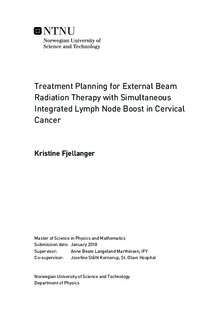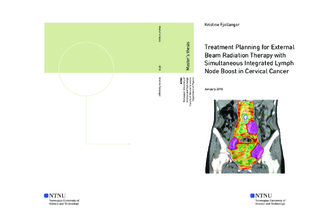| dc.description.abstract | Cervical cancer with lymph node metastases has traditionally been treated with external beam radiation therapy (EBRT) to a large pelvic target volume followed by a sequential boost to the affected lymph nodes, and brachytherapy to boost the primary tumor. With modern intensity modulated EBRT techniques (IMRT/VMAT) it has become possible to deliver the lymph node boost dose together with the initial pelvic EBRT as a simultaneous integrated boost (SIB).
The radiotherapy department at St. Olavs Hospital has decided to start using SIB in the treatment of this patient group. This is a study of treatment planning technique, aiming at exploring different aspects of SIB treatment planning for VMAT in the RayStation treatment planning system, assessing the achieved plan quality and presenting recommendations for the department protocol with regards to optimization functions, clinical and auxiliary structures and arc configuration.
5 patients that have received radiotherapy treatment with sequential boost for cervical cancer, each with 1-4 positive lymph nodes, were included in the study. SIB treatment plans with different types of optimization functions and auxiliary structures were created for all patients. The treatment planning aims from the EMBRACE II study protocol, regarded as the current gold standard for cervical cancer radiation therapy, were used for evaluation of the dose distributions along with visual inspection and QA measurements. After a general strategy for structures and objectives had been selected, plans with different arc configurations (1 arc, 2 single arcs or 2 arcs with RayStations dual arc feature) were created and compared.
A general objective set with corresponding auxiliary structures that should be a good starting point for the optimization process for most patients is presented. The SIB treatment plans made with 2 arcs were satisfactory as assessed by medical physicists and verified excellently according to the quality assurance procedure. Plans made with 1 arc displayed worse conformity of the high dose regions to the target volumes, and were not acceptable for 2 of the 5 patients.
Some challenges in the treatment plan creation were encountered. The clinical goals for the bladder were only achieved for 2 of the 5 patients, hence a change in the department protocol of treatment with empty bladder is recommended. Another issue was that due to the large target volumes, the treatment planning aims allowed significant cold areas. Thorough visual inspection of the dose distributions should therefore be performed. However, this study showed that implementation of SIB for lymph node metastases in cervical cancer is feasible in the current clinical setting at St. Olavs Hospital. | |

